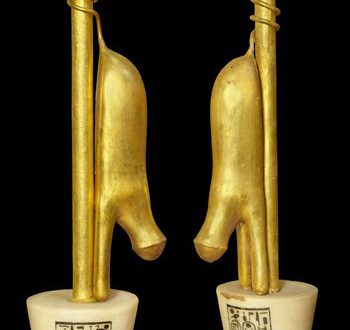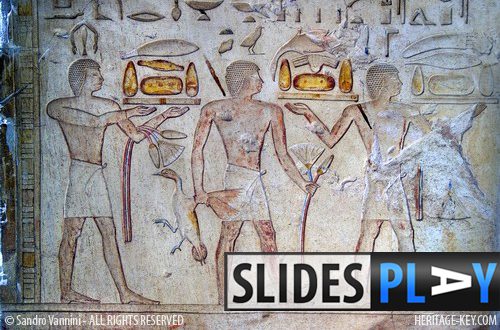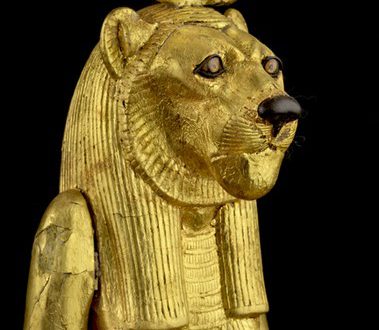 Several alabaster artefacts were discovered inside the Tomb of King Tutankhamun (KV62) by Howard Carter when he began excavating the tomb in 1922. The Canopic Shrine was one of the intruiging discoveries for how packed together it was, with a box containing several artefacts in a manner comparable to a Russian doll!
Several alabaster artefacts were discovered inside the Tomb of King Tutankhamun (KV62) by Howard Carter when he began excavating the tomb in 1922. The Canopic Shrine was one of the intruiging discoveries for how packed together it was, with a box containing several artefacts in a manner comparable to a Russian doll!
The Canopic Shrine is a large gilded wooden box flanked by a Canopy and supported on a sledge. Inside the shrine was the Canopic Chest, which has four hollowed spaces inside which are sealed by Human-Headed Stoppers. Inside the hollows were four small Canopic Coffinettes.
‘Canopic Shrine’ Slideshow
Heritage Key is working with Sandro Vannini and bringing his extensive catalogue of beautiful photography of Egyptian antiquities onto the world wide web, which we’re sure will fascinate even the most hardcore Egyptologist! To watch a slideshow of the Canopic Shrine, simply click any of the thumbnails below.
See it for yourself in King Tut Virtual
But it doesn’t stop there, as you can also visit King Tut Virtual and see digital recreations of many of the famous artefacts from KV62, walk through the Valley of the Kings, explore the banks of the River Nile in Ancient Egyptian times and even see more of Sandro Vannini’s photography in the virtual gallery.
Sandro Vannini’s Photography
Over a decade of experience in photographing the magnificent artefacts and tombs of Egypt has honed the skills of Sandro, and given him the experience required to capture the beautiful details of the Canopic Shrine. The equipment used to take the amazing photographs is obviously important too, and Sandro used a Hasselblad ELD Ixpress 528C camera to take these images. You can also see more of Sandro’s fantastic photography in his new book with the Director of the Supreme Council of Antiquities, Dr Zahi Hawass, “The Lost Tombs of Thebes: Life in Paradise” as well as reading about Sandro’s experiences of shooting the photographs in Thebes on Heritage Key, and watching the video about the Lost Tombs of Thebes featuring Dr Zahi Hawass and Dr Janice Kamrin (Watch the Video).
But for those of you who cant make the trip to the Cairo Museum to see the Canopic Shrine, Heritage Key offers these stunning photographs by Sandro Vannini. But there’s more: you can visit virtual replicas of Tutankhamun treasures in the Heritage Key’s King Tut exhibition, which features a virtual replica of many other breath-taking artefacts such as the Golden Mask of King Tutankhamun.
Don’t miss out on new treasures!
This post is part of a series focussing on amazing photographs from ancient Egypt. Keep checking back as well keep adding new images by Sandro Vannini. To make sure you don’t miss out on any of the updates, simply subscribe by email to receive notifications when new images are uploaded. For the more digitally advanced, there’s also an RSS feed with updates available.
See More Amazing Photography by Sandro
Have a look at some of the other stunning photographs by Sandro Vannini here at Heritage Key:
- The Cartouche Cosmetic Box
- The Canopic Chest
- Cosmetic Jar with Recumbent Lion
- Golden Mask of King Tutankhamun
Ask Sandro
We’ll be sitting down with our favourite photographer for an extended chat soon, so if you have any questions for Sandro we’ll send the answers straight to you!
The Canopic Shrine of Tutankhamun
The gilded wooden canopic shrine was set against the eastern wall of the Treasury positioned facing the west, the land of the dead. On top is a frieze of Solar Uraei (cobras with sun disks on their heads) which takes the form of the per wer. The walls are gessoed, gilded and decorated with paired images of goddesses and gods charged with protecting viscera of the king: Isis and Imsety (the liver), Nephtys and Hapy (lungs), Neith and Duamutef (stomach) and Selket and Qebehsenuef (intestines).
The Canopic Chest has no bottom and inside it atop a smaller sledge with silver coated runners stood a chest carved from a single block of calcite, the lid of the chest echoes the sloping roof of the outer shrine and canopy, while its sides are inclined and are decorated at their corners with carved images of the same four protective goddesses who stood on each side of the canopic shrine.
Each Canopic Jar is topped with a separately carved human/headed stopper in the form of the King in a nemes headdress made of calcite with details such as eyes, lips and ornaments on the protective uraeus and vulture picked out in red and black paint. The four stoppers are marked underneath with a symbol indicating their correct position with the four Canopic Coffinettes inside the hollows.
The miniature version of the royal coffins containing the embalmed and wrapped viscera of the king takes the form of mummiform figure of the king in the nemes headcloth fronted by cobra of the north and vulture of the south. On the chin the curled beard of divinity and the hands grasp a crook and a flail symbols of royal authority. On the sides are figures of Wadjet and Nekhbet as birds, in the talons the goddesses hold shen rings. The coffinettes are adorned to look as if they are covered with feathers (rishi style).
On the interior of the coffinette’s lid is engraved an image of the goddess Nut standing on the hieroglyph for the sky, her winged arms outstretched to protect the king on his journey to the next world. On the inside of the lower half of the coffin are inscriptions also designed to guard the king on his trip to the afterlife.
HDVideo:Tutankhamun’s Burial Treasures: The Canopic Shrine, Chest and Jars
(Read the transcript on the video page)
You can watch more fantastic videos on Heritage Key’s Video Page including Zahi Hawasss insights into the death of King Tut, as well as Kathleen Martinezs hunt for the tomb of Cleopatra. Additionally, you can find out more about Ancient Egypt on Heritage Key, as well as being able to explore the Valley of the Kings and the fascinating KV62 – King Tutankhamun’s tomb – in 3D in our exciting virtual experience! Also be sure to keep up to date on all new postings about Sandro’s photography from Egypt by subscribing to our feed, simply by entering your email address above.





